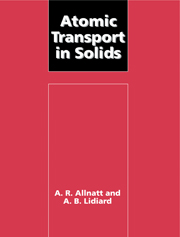Book contents
- Frontmatter
- Contents
- Preface
- List of principal symbols
- 1 Atomic movements in solids – phenomenological equations
- 2 Imperfections in solids
- 3 Statistical thermodynamics of crystals containing point defects
- 4 Non-equilibrium thermodynamics of atomic transport processes in solids
- 5 Some applications of non-equilibrium thermodynamics to solids
- 6 Microscopic theories – the master equation
- 7 Kinetic theory of relaxation processes
- 8 Kinetic theory of isothermal diffusion processes
- 9 The theory of random walks
- 10 Random-walk theories of atomic diffusion
- 11 Transport coefficients of dilute solid solutions – results and applications
- 12 The evaluation of nuclear magnetic relaxation rates
- 13 Theories of concentrated and highly defective systems
- References
- Index
7 - Kinetic theory of relaxation processes
Published online by Cambridge University Press: 28 December 2009
- Frontmatter
- Contents
- Preface
- List of principal symbols
- 1 Atomic movements in solids – phenomenological equations
- 2 Imperfections in solids
- 3 Statistical thermodynamics of crystals containing point defects
- 4 Non-equilibrium thermodynamics of atomic transport processes in solids
- 5 Some applications of non-equilibrium thermodynamics to solids
- 6 Microscopic theories – the master equation
- 7 Kinetic theory of relaxation processes
- 8 Kinetic theory of isothermal diffusion processes
- 9 The theory of random walks
- 10 Random-walk theories of atomic diffusion
- 11 Transport coefficients of dilute solid solutions – results and applications
- 12 The evaluation of nuclear magnetic relaxation rates
- 13 Theories of concentrated and highly defective systems
- References
- Index
Summary
Introduction
The theory presented in the last chapter has already provided important general insight into atomic transport coefficients, as well as specific results which define routes to the evaluation of these coefficients for particular systems, both dilute and concentrated. We could therefore go straight to these evaluations. However, there are good reasons for delaying the matter. One is that there are alternative approaches to dilute systems which convey particular insights into the processes of atomic transport and which define additional quantities of experimental interest, most notably the so-called correlation factor (Chapters 8 and 10). Two of the most important of these alternative approaches are the kinetic and random-walk theories: the former are the subject of this and the next chapter while the latter are dealt with in Chapters 9–10. Although these theories are very different in appearance we shall show that in the end they can lead to the same expressions for measurable quantities in terms of specific atomic features of the system under study. Ultimately therefore they may use the same techniques for the evaluation of these expressions (as we shall show in Chapter 11 especially).
Although we shall henceforth be much more concerned with the physical details of the systems of interest, both approaches relate rather closely to what we have presented in Chapter 6. We shall take kinetic theory first because it offers a rather direct representation of many of the basic equations of Chapter 6 together with a number of easily obtained approximate results for particular systems. At the same time some of its notions are useful in the development of the random-walk theories.
- Type
- Chapter
- Information
- Atomic Transport in Solids , pp. 247 - 269Publisher: Cambridge University PressPrint publication year: 1993



